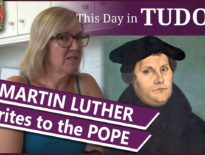On this day in Tudor history, 5th September 1569, in the reign of Queen Elizabeth I, Edmund Bonner, Bishop of London and a man nicknamed “Bloody Bonner”, died in Marshalsea Prison. He had started his career in Henry VIII's reign and was not just a churchman, he was also a diplomat.
In today's talk, I flesh out this Tudor bishop who got his nickname from being in charge of burning reformers in London. Find out about his life, career and how he ended up dying in prison.
Also on this day in Tudor history, 5th September 1548, Catherine Parr, Henry VIII’s sixth and final wife, died at Sudeley Castle in Gloucestershire. At the time of her death, Catherine Parr was the wife of Thomas Seymour, Baron Seymour of Sudeley, her fourth husband, and she had given birth to a daughter, Lady Mary Seymour, on 30th August 1548. Find out more about her burial, the discovery of her remains in the 18th and 19th centuries, and her present resting place, in last year’s video:
Also on this day in history:
- 1558 (5th or 6th September) – Death of Sir Robert Broke, Judge, legal writer and Speaker of the House of Commons, at a friend's house in Patshull, Staffordshire. He was buried in Claverley Church, Shropshire. Broke also served as Deputy Chief Steward for the Duchy of Lancaster, Serjeant-at-Law and Chief Justice of the Common Pleas.
Transcript:
On this day in Tudor history, 5th September 1569, Edmund Bonner, Bishop of London and a man nicknamed “Bloody Bonner”, died in Marshalsea Prison.
Let me tell you a bit more about this bishop who got his nickname from being in charge of burning reformers in London…
Edmund Bonner was born in around 1500, in the reign of King Henry VII, probably in Hanley in Worcestershire. His parents were sawyer, Edmund Bonner, and Elizabeth Frodsham, although it was rumoured that his real father was George Savage, rector of Davenham in Cheshire.
He was educated at Broadgates Hall, now Pembroke College, Oxford, where he studied civil and canon law. In 1526, he received a doctorate in civil law and was admitted to the College of Advocates, London.
In 1527, he undertook a diplomatic mission to the Netherlands, and by 1529 he was serving Cardinal Thomas Wolsey as a chaplain. In August 1529, he went to France on a mission for King Henry VIII. Following Cardinal Wolsey's fall in 1530, he served Thomas Cromwell. In January 1532, he was sent to Rome by the king, and in 1536, he was sent to negotiate with the Protestants of Denmark and northern Germany. Two years later, the king sent Bonner to negotiate with the Holy Roman Emperor regarding a general council and then he was sent to King Francis I's court in France, where he served until early 1540. He served as an ambassador to the emperor in Spain and Germany in 1542 and 1543.
Bonner was elected Bishop of Hereford in 1538 and then in 1539, he was elected as Bishop of London following the death of John Stokesley.
In Edward VI’s reign, Bonner opposed the religious changes implemented by Edward Seymour, Duke of Somerset and Lord Protector, and Archbishop Thomas Cranmer. In 1549, he was committed to Marshalsea Prison and deprived of his bishopric after he had neglected to enforce the Act of Uniformity and Book of Common Prayer. He had also preached in support of miracle of the eucharist and had not followed orders to preach in support of the king's authority.
The accession of the Catholic queen, Mary I, in July 1553 led to Bonner's release and restoration as Bishop of London. Bonner set about restoring the old faith in London and in 1555 began his persecution of people he deemed heretics, for which he became known as "Bloody Bonner". His Oxford Dictionary of National Biography biographer, Kenneth Carleton, notes that “Of 282 burnings recorded in episcopal registers for the period, 232 took place in the dioceses of London, Canterbury, Norwich, and Chichester; half the burnings in these four dioceses took place in Bonner's see of London.” In 1556, he was involved in the degradation of Archbishop Cranmer.
Mary I died on 17th November 1558 and her Protestant half-sister, Elizabeth, became queen. Bonner refused the oath of supremacy in May 1559 and so was deprived of his bishopric. In 1560, he was imprisoned once more in Marshalsea Prison. In 1564, he again refused the oath, a capital offence, but he escaped death when he argued that the consecration of Bishop Horne, who had tendered the oath was not legal. He spent the rest of his life in prison and died in the Marshalsea on this day in 1569.
His written works include Responsum et Exhortatio in laudem Sacerdotii (1553); Articles to be enquired of in the General Visitation of Edmund Bishop of London (1554); and Homelies sette forth by Eddmune Byshop of London, ... to be read within his diocese of London of all Parsons, vycars and curates, unto their parishioners upon Sondayes and holy days (1555), A Profitable and Necessary Doctrine with Certain Homilies Adjoined Thereto (1555).
His role in the Marian persecutions was emphasised by the work of martyrologist John Foxe. Kenneth Carleton concludes "He seems to have become more violent as he grew older, perhaps as a result of his harsh confinement in the early 1550s; even so, it is possible that some of his reported excesses of behaviour were intended to frighten heretics into recantation and so to save them from the flames. Although clearly a difficult personality, it is none the less unfortunate that his reputation for cruelty has come to overshadow many years of valued service to both church and state."
Bonner was buried at St George's, Southwark, but it is thought that his remains were later moved to Copford, near Colchester, a manor held by Bonner as Bishop of London.



Leave a Reply